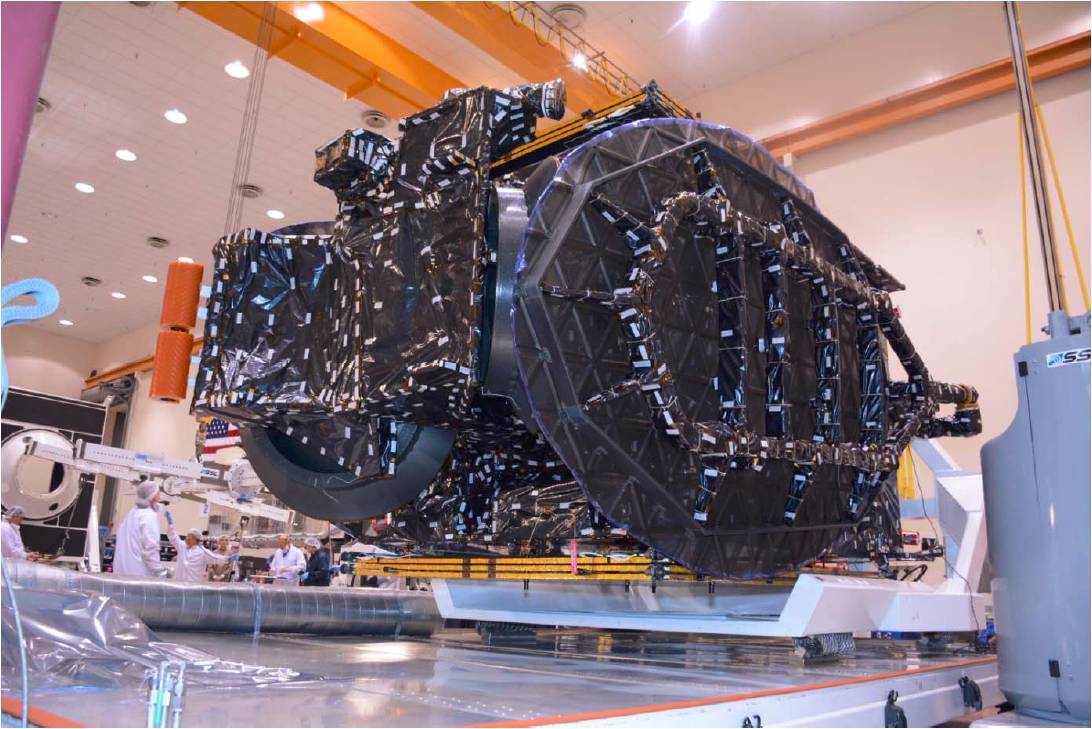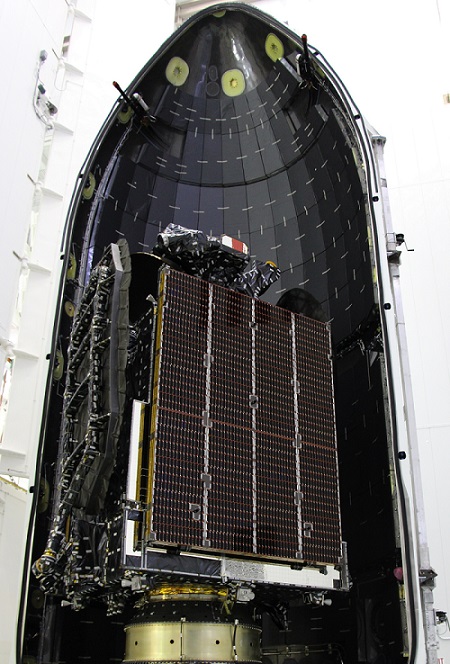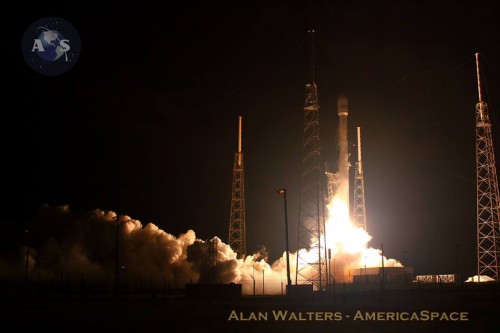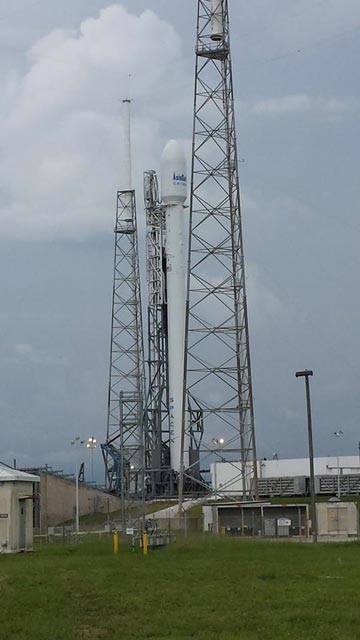
Two weeks later than planned, SpaceX is tracking a revised launch attempt for the AsiaSat-6 geostationary mission early Sunday, 7 September. According to the 45th Space Wing, SpaceX will fly its fifth Falcon 9 v1.1 vehicle of 2014 from Space Launch Complex (SLC)-40 at Cape Canaveral Air Force Station, Fla., during an expansive “window” which extends from 12:50 a.m. until 4:04 a.m. EDT. A backup opportunity also exists on Monday, 8 September. Originally targeted for late last month, the mission was postponed in the aftermath of the 22 August explosion of the Falcon 9 Reusable Development Vehicle (F9R Dev) and succumbed to a lengthier delay as SpaceX opted to review the cause of the failure and its implications for future Falcon 9 v1.1 missions. By late Friday, 5 September, official word from the Air Force, SpaceX and AsiaSat confirmed that a Sunday morning launch attempt would be made and the 45th Space Wing has invited members of the media to set up cameras near SLC-40 on Saturday afternoon to acquire images of the vehicle on the pad.
Although SpaceX—the Hawthorne, Calif.-based launch services provider, headed by entrepreneur Elon Musk—had Eastern Range clearance to fly early on 26 August, it chose to delay by 24 hours, following the F9R Dev explosion on 22 August. “While Friday’s F9R three-engine, single-stage test article and our launch site in McGregor, Texas, are very different from the planned Cape Canaveral, Fla., launch of the AsiaSat-6 satellite on the Falcon 9 rocket,” SpaceX reported in a 24 August statement, “we are taking some additional time to review the circumstances that caused the test vehicle to auto-terminate to confirm that there is not a risk to orbital flight.”
Rescheduled for 27 August, the second attempt was called off about 10 hours before the opening of the launch window and postponed by up to two weeks, reportedly to allow additional verifications of “the Falcon 9 fault detection and recovery logic, with particular focus on highly improbable corner-case failure scenarios.” Much speculation has abounded in recent days of a launch No Earlier Than (NET) Saturday, 6 September. Although the 45th Weather Squadron confirmed Thursday that SpaceX was officially aiming for NET Sunday, 7 September, Musk’s company initially refrained from significant comment, remarking only that “We will update with more information when it is available.” However, late Friday afternoon, SpaceX and AsiaSat confirmed that they were aiming for an early Sunday launch.

At the present time, Patrick Air Force Base meteorologists are predicting a 70 percent likelihood of acceptable weather conditions for a Sunday launch, with primary concerns centering upon the possibility of violating the Thick Cloud Rule. In the event of a 24-hour delay until the backup launch opportunity on Monday, 8 September, the likelihood of acceptable weather is expected to increase to 80 percent favorable. “A slow-moving tropical wave is transiting Central Florida,” it was noted. “Most of the associated cloud cover, rain showers and lightning have remained east of the Space Coast. On Saturday, the wave will stall and weaken in North Florida, keeping most of the inclement weather north-east of the space port. On Sunday and Monday, the wave is forecast to continue weakening, decreasing the likelihood of a launch rule violation.”
Assuming a successful launch over the weekend, the delivery of AsiaSat-6 into geostationary transfer orbit at an altitude of 22,300 miles (35,900 km) will come a month after the 5 August launch of AsiaSat-8. As with its sibling, the geostationary requirement of this heavyweight mission requires the maximum performance capability of the Falcon 9 v1.1, and consequently the booster will not be equipped with extendible landing legs and will not perform a “propulsive return-over-water” and controlled splashdown.
In spite of a frustrating summer, which saw the Orbcomm OG-2 mission delayed repeatedly, prior to a successful launch on 13 July, SpaceX picked itself up and scored two “personal bests” with AsiaSat-8, delivering two payloads within three weeks and achieving a record fourth flight in a single calendar year. This achievement follows on the heels of two earlier successes in 2014: the delivery of the Thaicom-6 satellite into geostationary transfer orbit in January and the launch of the third dedicated Dragon cargo mission (SpX-3) toward the International Space Station (ISS) in April, fulfilling part of SpaceX’s $1.6 billion Commercial Resupply Services (CRS) contract with NASA.
The two-stage Falcon 9 v1.1 rocket for the AsiaSat-6 mission—which will be making its seventh total flight in less than 12 months—will undergo fueling with liquid oxygen and a highly refined form of rocket-grade kerosene (known as “RP-1”) late Saturday evening. The cryogenic nature of the oxygen—whose liquid state exists within a temperature range from -221.54 degrees Celsius (-368.77 degrees Fahrenheit) to -182.96 degrees Celsius (-297.33 degrees Fahrenheit)—requires the fuel lines of the Merlin-1D engines to be chilled down, in order to avoid thermally shocking and fracturing them. Within an hour, all propellants should be fully loaded.
At 12:37 a.m. EDT Sunday, the countdown will reach its final “Go-No Go” polling point of all stations at T-13 minutes. Assuming that the Falcon 9 v1.1, the AsiaSat-6 payload and all supporting facilities pass smoothly through the polls, the terminal countdown will get underway at T-10 minutes. During this phase, the Merlin-1D engines will be chilled, ready for their ignition sequence, and at 12:43 a.m. AsiaSat-6 will be transferred to internal power and the rocket itself transitioned to its on-board batteries. All external power utilities from the Ground Support Equipment (GSE) will be disconnected, and at 12:45 a.m. the approximately 90-second process of retracting the “strongback” away from the vehicle will get underway. The Flight Termination System (FTS)—tasked with destroying the rocket in the event of a major accident during ascent—will be placed onto internal power and armed.

By T-2 minutes and 15 seconds, the first stage tanks will reach flight pressure. The Merlin-1D engines will then be purged with gaseous nitrogen and, at T-60 seconds, SLC-40’s “Niagara” deluge system of 53 nozzles will be activated, flooding the pad surface and flame trench with 30,000 gallons (113,500 liters) of water, per minute, to suppress acoustic waves radiating from the engine exhausts. At T-3 seconds, the nine engines will roar to life, ramping up to a combined thrust of 1.3 million pounds (590,000 kg). Following computer-commanded health checks, the Falcon 9 v1.1 will be released from SLC-40 to commence SpaceX’s fifth mission of 2014, turning night into day across the marshy Florida landscape.
Immediately after clearing the SLC-40 tower, the rocket will execute a combined pitch, roll, and yaw program maneuver to establish itself onto the proper flight azimuth to inject AsiaSat-6 into geostationary transfer orbit. Eighty seconds into the ascent, the vehicle will exceed the speed of sound and experience a period of maximum aerodynamic stress (colloquially known as “Max Q”) upon its airframe. At about the same time, the Merlin-1D Vacuum engine of the second stage will undergo its own chill-down process, preparatory to its own ignition later in the ascent phase. At 12:52 a.m., 130 seconds after liftoff, two of the first-stage engines will throttle back, under computer control, in order to reduce the rate of acceleration at the point of Main Engine Cutoff (MECO).
Finally, at 12:52:41 a.m., the seven remaining first-stage engines will shut down and the lower component of the Falcon 9 v1.1 will separate from the rapidly ascending stack. The turn will then come for the restartable second stage, whose single Merlin-1D Vacuum engine—with a maximum thrust of 180,000 pounds (81,600 kg)—will roar to life at 12:52:49 a.m. to continue the boost to deliver AsiaSat-6 into orbit. Thirty seconds into its burn, the 43-foot-tall (13.1-meter) payload fairing will be jettisoned, exposing the satellite to the space environment for the first time. Finally, the Merlin-1D Vacuum will shut down at 1:09:35 a.m., after which the stack will coast for 17 minutes, prior to a restart at 1:26 a.m. AsiaSat-6 will be released from the second stage into free flight a few minutes later at 1:32 a.m.

Built by Space Systems/Loral (SS/L), the cube-shaped satellite weighs 8,100 pounds (3,700 kg) and represents one of the largest and most powerful AsiaSats ever inserted into orbit. Following initial checkout, AsiaSat-6 will be positioned at 120 degrees East longitude. It will be operated by the Asia Satellite Telecommunications Company Ltd., headquartered in Hong Kong, and 14 of its 28 high-powered C-band transponders will be leased to Thaicom—under a $171 million, 15-year contract, signed in December 2011—who will market them as “Thaicom-7.” The satellite is equipped with one “global” beam and one “regional” beam, providing region-wide coverage of Asia, Australasia, Central Asia, and the Pacific Islands, with enhanced power and look angles over Pacific Rim countries.
AsiaSat selected SS/L in November 2011 to build its AsiaSat-8 and AsiaSat-6 platforms, both of which are expected to support 15-year operational lifetimes. Based upon the LS-1300 “bus,” with a pair of deployable solar arrays and batteries, both satellites breezed through thermal vacuum tests last December and underwent dynamic tests and Compact Antenna Test Range (CATR) tests in January-February 2014. The latter allowed engineers to measure antenna and payload performance and demonstrate their compliance with spacecraft specifications. “These critical tests are essential,” AsiaSat reported in December 2013, “in order to achieve the highest quality and reliability of the spacecraft before shipment to the SpaceX launch pad at Cape Canaveral.”
AsiaSat-6 was delivered to the Cape on 31 July to begin final processing ahead of its Falcon 9 v1.1 launch. Following extensive tests, the satellite was encapsulated within its bulbous payload fairing. The size and mass of the satellite demands a 17.1-foot-diameter (5.2-meter) fairing, which stands about 43 feet (13.1 meters) tall.
The arrival of AsiaSat-6 will mark the 10th in a series of satellites, which can trace its ancestry back almost a quarter-century. AsiaSat-1, launched atop a Chinese Long March-3 booster in April 1990, had an interesting back story, for it was originally the Westar VI communications satellite, delivered into an improper orbit by shuttle mission 41B in February 1984 and triumphantly retrieved and returned to Earth by the 51A crew the following November. AsiaSat-2 followed in November 1995, also aboard a Long March rocket, after which the third (AsiaSat-3) and fourth (AsiaSat-3S) satellites in the series were delivered by Russian Proton-K boosters in December 1997 and March 1999. The latter replaced the decomissioned AsiaSat-1 from May 1999 and is today the oldest member of the fleet still in operational status. Kicking off the 21st century, AsiaSat-4 rode an Atlas IIIB from Cape Canaveral in April 2003, followed by AsiaSat-5 atop a Proton-M/Briz-M from Baikonur in August 2009, AsiaSat-7 in November 2011, and AsiaSat-8 in August 2014.
AsiaSat-5 entered the headlines in the summer of 2014, during the World Cup coverage from Brazil, when it delivered the first-ever live telecast of the international football competition in 4K resolution. Commonly (though not strictly accurately) known to the general consumer as “ultra-high-definition television” (UHDTV), 4K produces horizontal resolution of close to 4,000 pixels, more than four times higher than standard HDTV and capable of 60 frames per second. AsiaSat-5 delivered live 4K coverage of the Colombia-Uruguay Round of 16 match on 28 June, followed by the Germany-France quarter-final on 4 July and the final, between Germany and Argentina, on 13 July. According to AsiaSat, the worldwide number of 4K television households is expected to rise from 2.2 million at the end of 2013 to as high as 66.2 million by the end of 2018. Moreover, the Asia-Pacific region is forecasted to become the single largest 4K television market by 2016, accounting for 42 percent of global 4K television households.
Want to keep up-to-date with all things space? Be sure to “Like” AmericaSpace on Facebook and follow us on Twitter: @AmericaSpace




Elon Musk for Nobel, sign it.
http://www.change.org/p/the-nobel-prize-committee-nobel-prize-in-economics-to-elon-musk